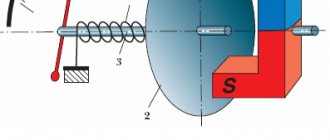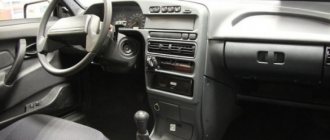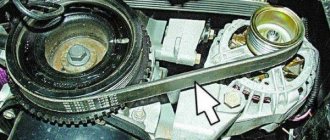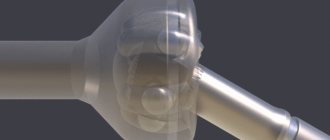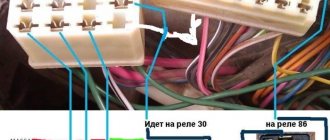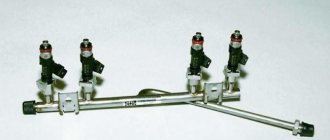- Is it worth installing electric power steering?
- What do you need for installation?
- Installation instructions
- Adjusting the steering wheel position
From its very production, the steering system of the VAZ 2114 car assumed the possibility of installing power steering using an installation kit. This also applies to electric power steering or simply EUR.
This modification will make it easier to turn the car and increase comfortable handling. This is especially true for drivers who drive in the city most of the time.
The main difference between power steering (power steering) and electric power steering is that the strength (efficiency) of the former directly depends on the speed of the engine. At high speeds, turning the steering wheel is too easy. This affects both ride feel and handling.
To overcome such problems, the power steering is not connected directly to the motor, but using a gain regulator. This is exactly the functionality that an electric amplifier has. The operation of the electric power steering is not characterized by a direct connection between effort and motor power, which allows it to be used as much as necessary in a specific situation.
Electric power steering for VAZ 2114
For the VAZ 2114, a similar EUR is suitable as for the Lada Priora.
Additional advantages of using an electric booster instead of power steering:
- Less maintenance requirements (no need to monitor oil, connections).
- In cold weather there is no need to warm up, as when using power steering.
- Installing the EUR is much easier (no need to interfere with the engine compartment).
- High reliability.
- The only downside is the lower power, although on passenger cars like the VAZ 2114 this is not at all noticeable.
Installation instructions
Installing the main unit
When installing an electric power steering, it is necessary to take into account that it will be necessary to replace the steering column of the VAZ 2114 with an “electrically driven column”. To do this, let's start with the wiring. You will need to deal with the pads. There will be no need for any “twists”. There is a terminal in the block that we need to remove and insert into the block in the harness.
We insert the free terminal of the harness exactly into the place where the standard wire was. You don't need a special harness for this. Connect two 4 square wires to the battery. Don't forget to connect a 50A fuse. The “weak point” will connect to the tachometer, speed sensor, ground, K-line and wiring to the warning lamp. Don't forget to check the presence of speedometer and tachometer signals.
- Remove the casing with switches and ignition switch.
- Unscrew the bolt on the rail and remove it. We need to determine how much larger the “native” part is than our new one.
- We install the shaft on the EUR. After this we attach the shaft itself in its place.
- Setting up the wiring. We stretch two cables to the battery from the passenger compartment, preferably through the left wing. To conduct wiring you can:
- First remove the washer fluid reservoir.
- Take a solid wire and drag it through, trying to get to the hood.
- As soon as it appears near the hood, we attach our wires to it.
Location of mounts for electric power steering in a VAZ 2114
- We pull it out together with our wire.
- We connect the EUR electronics. There is a red connector under the instrument panel with an orange wire in it. It is to this that you need to connect the electric amplifier.
- Similar procedures must be done with the gray wire.
- We connect the power ends. In the battery we connect the pink one is a plus, and the black one is a minus.
The installation is now complete. If you did everything carefully according to the instructions, you will enjoy the ease of driving the VAZ 2114.
Installing electric power steering on a VAZ 2114
I rode my father’s viburnum and realized that there was no escaping progress, especially since I plan to change the rack by 3.2, or even 2.5 turns, and without an amplifier there will be no life at all. I bought it at Stinger. The kit includes everything you need: 1. The amplifier itself (a new model, not glitchy in short). 2. Adapter. 3. Steering shaft. 4. Wiring. From myself: 1. I don’t see any problems with the mechanics. 2. For electrical purposes, you need to look for a connection diagram.
I started to disassemble: 1. Removed the steering casing (nothing complicated). 2. Disconnected and removed all switches (wipers and lights). 3. Removed the ignition switch (the first problem is that you need to unscrew the bolts with a chisel, since there are no edges (!). 4. Use a chisel to straighten the clamp securing the shaft and steering rack (at the engine shield). 5. Use a chisel to unscrew the two bolts securing the steering column (also quite inconvenient). the adapter is attached, I'll clamp it in a vice and knock it out through the sleeve). 10. Measured so that only a little bit came out of the nut and sawed it off (you can use a grinder, I made do with a saw and a file). EUR to the adapter (four nuts for 13 plus growers). 14. Replaced the ignition switch (I used hex bolts, it’s more convenient).
Photo: 1. Standard steering column without casing. 2. Steering column mount. 3. EUR in place).
Electrics
Mechanically: I bought: 1. Adapter for steering wheel (for Priora). 2. Steering column switch block (also from Priora) 3. Steering column cover from Priora (not yet available). I installed everything, although I haven’t figured out the sound signal yet, but I’ll do that one of these days)). Electrics: 1. Extended the power wires to the battery (plus with a fuse, minus just a wire). 2. Tightened the ground (black thin wire for controlling the power steering, screwed under the instrument cluster). 3. Connected the wires to the instrument cluster. 3.1. The orange wire from the red block to the first from the EUR block is double yellow-red (photo 2). 3.2 Gray + yellow wires from the red block to the third from the EUR-blue block (photo 4). 3.3 Brown-red from the white block to the second block from the EUR-brown block (photo 3). In photo 5 from bottom to top: 1. Yellow-red. 2. Brown. 3. Blue. 3.4 There are also wires there, for k-line and so on, I didn’t connect them (wiring for Priora is not provided in Samara). 4. Collected everything.
Now the feelings: 1. Yes, everything is super 2. At low speeds it’s just a fairy tale) 3. As the speed increases, it turns off and the car steers as before (that is, clear and intelligible feedback). 4. Unlike the early Kalinovsky EURs, this one, when turned off, does not betray its presence in any way (I don’t feel it at all).
Disadvantages: 1. Because of the adapter, the steering wheel dropped (not fatal, but still). 2. The bullet column has lengthened, the steering wheel has become closer to the driver (in principle, everything can be treated by adjusting the seat and I, at 186 cm, did not experience any inconvenience). 3. The steering wheel covers the instrument cluster.
To the diagram: 1. Power steering harness; 2. EURU power supply circuit fuse; 3. Diagnostic contacts of the EURU harness; 4. EURU; 5,6,7 - connecting blocks of the electrical power steering harness, connected to the wires of the instrument panel harness, disconnected from the blocks to the instrument cluster; 8. Block (red) of the instrument panel harness to the instrument cluster; 9. Block (white) of the instrument panel harness to the instrument cluster; 10. Alarm block; 11. Ground terminal.
From myself: THE COLOR OF THE EUR WIRES MAY DIFFER.
1. Button: well, it’s not realistic to put it in its regular place, so I had to think about it. The task was to save the button, not to cut the wiring and place it in a convenient place - as a result, it is now on the panel. I am comfortable.
2. Tilt of the steering column: I placed washers under the far fasteners (which are closer to the engine compartment) of the EUR with an adapter, with them the angle of the steering column changed and the steering wheel no longer covered the instrument cluster.
Adjusting the steering wheel position
If you don’t like the height and position of the steering wheel, then you will need to grind the edges of the shaft to the size you need or install gaskets between the plate and the body. It is worth remembering that the electric power steering is automatically switched off at speeds above 50 km/h, unlike the same power steering.
Installing electric power steering on your own is quite possible. You just have to remember that even for an experienced driver it will take a lot of time and effort. But for a lover of comfortable driving, the result will justify all costs and hopes.
How to install electric power steering on a VAZ 2114
2001 was the year of the appearance of a new project from the domestic automaker AvtoVAZ. The model had two names - Samara-2 or VAZ 2114. In fact, it was an improved version of the well-known nine.
EUR kit
The modernization turned out to be very serious, affecting literally all components of the car. The steering system was no exception. Unlike many other models produced by AvtoVAZ, the 2114 offered a choice of two power steering units at once - hydraulic power steering and electric power steering.
Types and advantages of power steering
Since we are talking about the VAZ 2114 and its technical properties, we cannot remain silent about its steering and how it can be made better. Today, the driver is faced with a choice between two power options: EUR (or EMUR) and power steering on a VAZ. But what are they, what are their design differences, features and, possibly, disadvantages?
EPS is an electric power steering, it is a unique device built on the principle of electric current pulses. The electric power steering on a VAZ is a rather complex system, where each part has its own role, if it fails, the whole device breaks down, and the steering also malfunctions.
That is why it is necessary to timely monitor the condition of the steering mechanism so that it does not fail somewhere unexpectedly along the way. The current pulses in the EUR are monitored by a device called a controller, and the degree of amplification can be adjusted at will. So, what tasks does the EUR perform?
- ESD has a positive effect on the controllability and maneuverability of the car, allowing the driver to “hold” the car and “feel” its progress, whereas without this device a car, especially a domestic one, moves very mediocrely;
- The EUR becomes simply an irreplaceable thing during temperature changes, which occur quite often in Russia. So, usually in severe January frosts the entire system fails, but the amplifier helps to overcome this test with dignity, since it is not affected in any way by even the most powerful changes in air temperature;
- Thanks to the strengthening of the steering mechanism, fuel is saved significantly, since the degree of strengthening can be adjusted and fuel consumption can be controlled.
In addition to electric power steering, there is also power steering. This is a complex mechanism that requires careful handling and constant monitoring, consisting of a large number of parts. The operating principle of this type of amplification is based on the interaction of power steering and oil fluid, which is poured into the device’s reservoir. That is why it is called power steering, since its actions are based on the working force of the fluid.
The technology of operation of the amplifier is complex, but the main thing here is that it is very effective, guarantees safe and comfortable driving, and allows you to maintain vehicle controllability even in the event of serious problems with the front tire. The only disadvantage of the device is its frequent failure and oil leaks. The power steering performs the following tasks:
- makes the car more controllable, lighter, more maneuverable;
- softens the shocks that fall on the steering wheel while driving on not the best roads. People who are accustomed to driving not on ideal routes, but on country roads, understand the value of power steering like no one else;
- the device allows you to “feel” the track and your car, which gives you confidence on the road;
- By means of steering assistance, the number of steering revolutions is reduced, which is also a huge plus.


